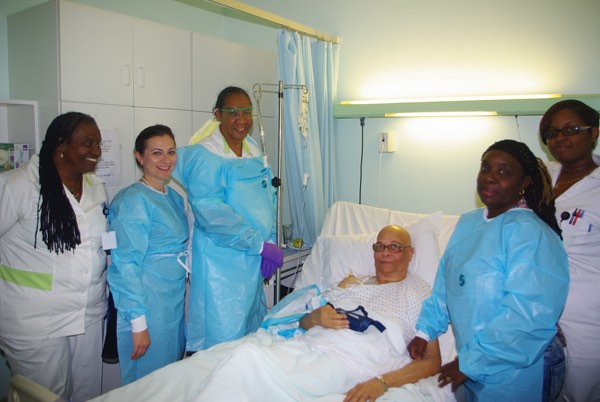Chemotherapy Pumps Introduced at SMMC
Cayhill-For the first time, on Monday, March 2, 2015, the outpatient department administered chemotherapy treatment via an elastomeric pump.
An elastomeric pump is a light weight disposable pump that can be used to give medications such as chemotherapy. The balloon pump squeezes the chemo-medication out of the balloon through the tubing via a catheter into the patient’s blood stream.
Patients who need to get chemotherapy for extended days in the hospital may receive a “pump”. This is a small disposable pump that is attached to the patients’ catheter (port). The pump is carried in a pouch that can be worn around the waist. The pump enables the patient to receive chemotherapy safely and comfortably outside of the hospital, so the patient can continue life’s daily activities while the pump is attached.
Milagros Serrano, Head Nurse Oncology at HIMA Cancer Center in Puerto Rico, instructed the Outpatient Department oncology nurses on the use of the pump. Nurse Serrano supervised the administering of the medication into the pump at the Cay Hill Pharmacy. She then supervised and gave support as the nurses connected the pump to the first patient, Ms. Grace Nisbeth. “I’m so happy to be part of this history in this hospital,” said Nurse Serrano.
Surely, Nurse Serrano was not the only happy person! Grace was excited about being the first chemotherapy patient at the SMMC to receive treatment with the pump. “I am very optimistic, I have excellent oncology nurses,” she said, “they are very knowledgeable and compassionate; a good combination! So I am not nervous.”

Ms. Nisbeth was diagnosed with cancer in June 2014. The retiree enjoys reading and gardening. With the pump, she can tend to her garden while she gets her treatment. “There is nothing like being in your own home, doing whatever you want, whenever you want to,” Ms. Nisbeth said.
When the nurses connected Ms. Nisbeth to the pump she said, “Great, I’d be home by five o’clock”.
Previously, every three to four weeks, Ms. Nisbeth would spend two and a half days in the hospital in order to get her full chemotherapy treatment. Now, this time is remarkably shortened to a few hours during which she will get standard chemotherapy via an Intravenous line.
Ms. Nisbeth returned to the hospital to remove the pump three days later; the flow of medication was too slow in the beginning and had to be adjusted the following day. Normally, the chemo pump would be used for two days at home.
At her outpatient visit, Ms. Nisbeth spoke about receiving her treatment at home, “It was comfortable. I enjoyed the freedom of being able to move around and eat whatever I want, sleep in my own bed.” Even with the support of her sisters at home, Ms. Nisbeth felt independent about her care while using the pump. In comparison to the way she would receive her treatment before, she said, “This is a much better idea! There isn’t much to manage with a chemo pump. I would encourage anyone taking chemo to use this.” Ms. Nisbeth thinks the chemo pumps are a good step forward.
Indeed, the chemo pumps are just one of several steps forward the outpatient department is taking. The Outpatient Department gave its first Chemotherapy treatment in a small office in 1997. The treatment was given once a week due to the fact that, at that time, the oncologist would visit from Curacao on Thursdays and leave on Saturdays. Giving chemotherapy on Friday also gave the patients time to recuperate in the weekend before going back to their daily activities. Years later, chemotherapy was moved to the patient ward where all intravenous therapies are given on the traditional Fridays.
This is going to change to a full daily treatment later in March with the move to a new oncology/chemotherapy room. Chemotherapy being available every day of the week will give the patient more flexibility in their daily schedules. Now, with the introduction of the chemo pumps, some patients can have greater flexibility.
“We want to give our patients the advantage of being treated in their own environment. The pump is safe and requires less handling and administering of medication, which also reduces the chances of making errors,” said Nurse Jasmien Cijntje, supervisor outpatient department.
The patients can call on the nurses anytime if they feel uncomfortable or experience any problems with the pump. If they cannot come to the hospital, our nurses will go to them to assess the situation.
The outpatient department hopes to offer the pumps to more patients in the near future.
###
In photo: Nursing Educator Brunilda Illidge, Nurse Milagros Serrano, Nurse Jasmien Cijntje with Grace Nisbeth and outpatient/chemotherapy nurses.
In photo: Nurse Serrano and Pharmacy Assistant Jacky Kortlecen preparing the pump.